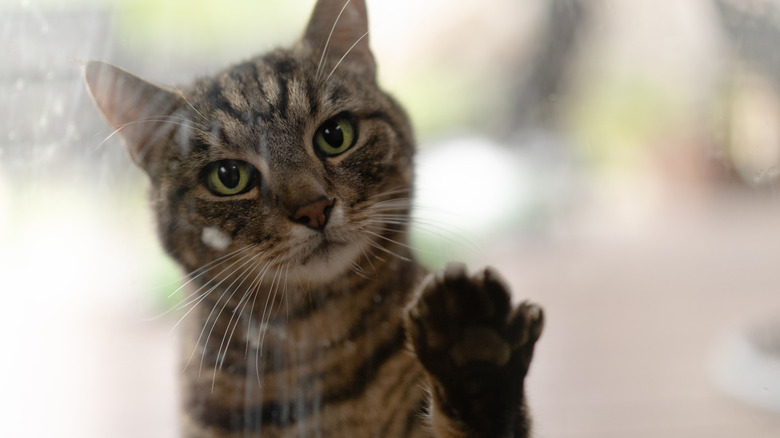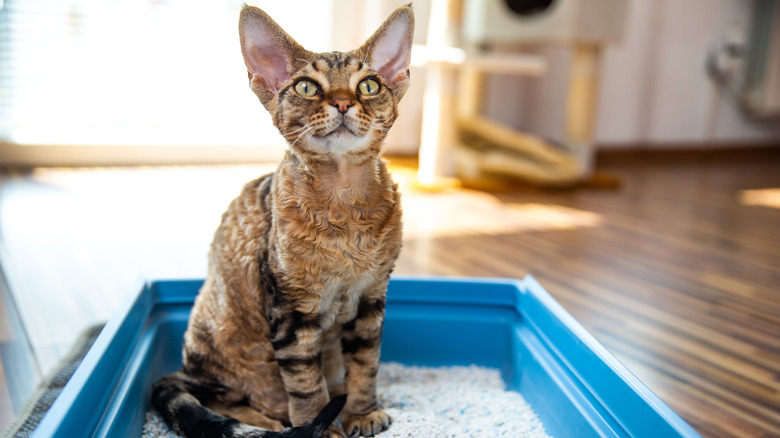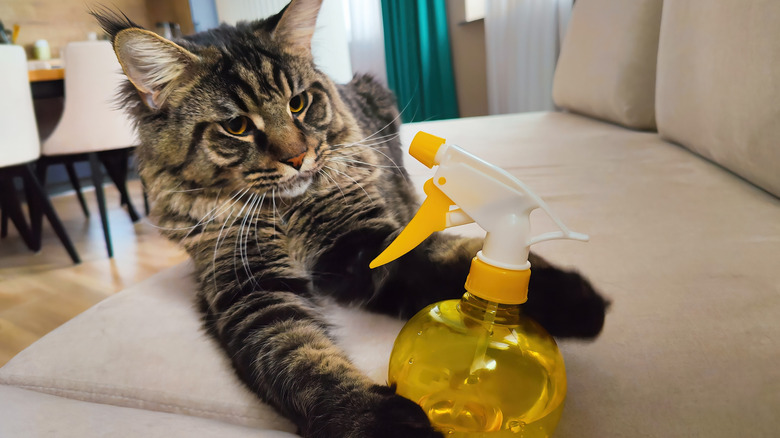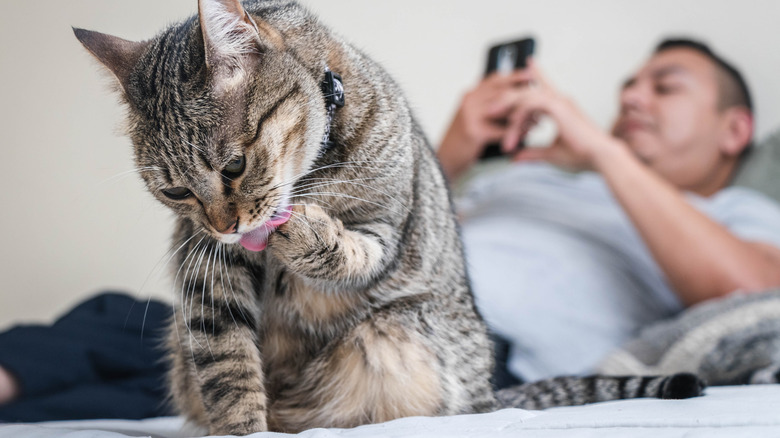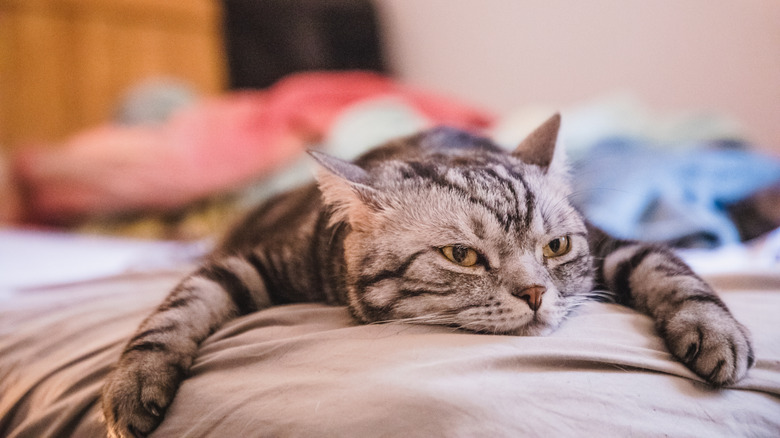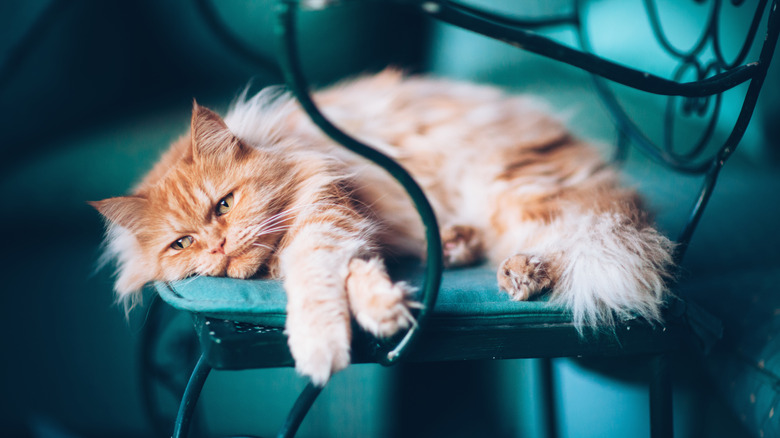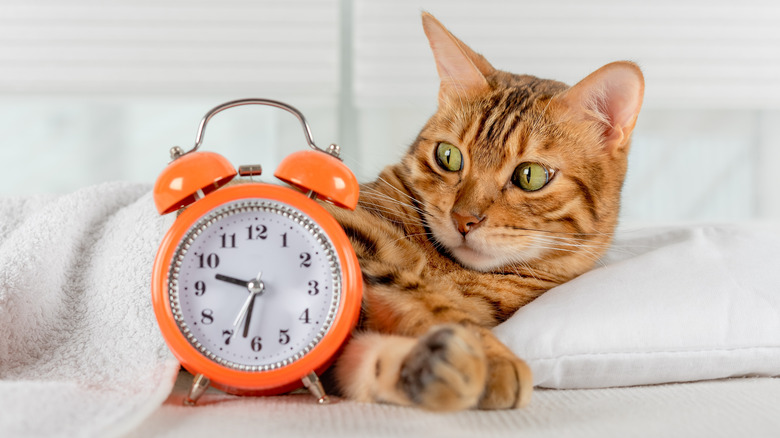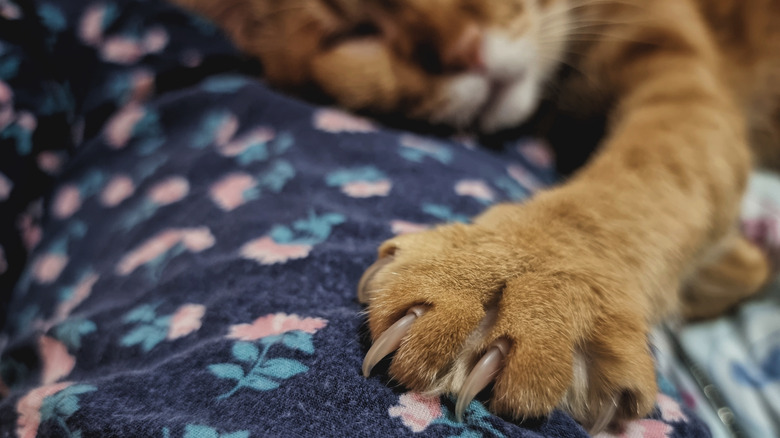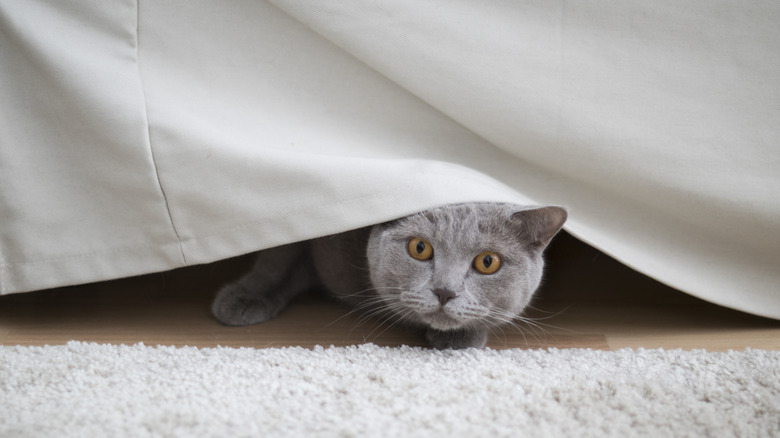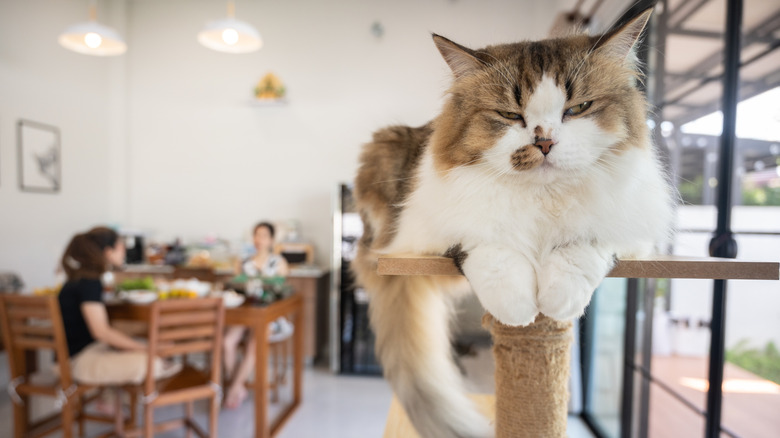13 Things You Do That Break Your Cat's Heart
We may receive a commission on purchases made from links.
Cats have a reputation for being aloof, but a lot of feelings go on inside those furry little bodies. If seeing a cat launch into delighted play, cuddle contentedly into a safe place, raucously demand food, or pine for a lost loved one isn't proof enough of their emotional range, consider that a growing body of science is telling us that cats not only have emotion and more nuanced facial expressions than many of us ever imagined, but they also crave time with the humans in their lives — to the point that many would choose us over food or toys.
Of course, there are always a few exceptions, including non-feral cats that, although they deign to live with us, don't actually want to interact with humans beyond meal times. But the more we learn about cats, the clearer it becomes that, independent though they may be, it's unfair to treat them like the cold creatures they're often portrayed to be. And that begs the question: What choices might you be making that actually break your cat's heart?
1. Not prioritizing your cat's litter box
If we don't scoop waste out of the litter box frequently enough, offer our cats enough litter boxes, or put litter boxes in places that are convenient for our cats — which often aren't the same places that are convenient for humans — they may act out. Behaviors like inappropriate urination may be the only option they have to express that something is fundamentally wrong in their world.
The good news is that you can redeem yourself by following the basic rules of litter-box maintenance. Scooping litter boxes every day gets you a gold star, as does following the general rule that you should have one litter box per cat, plus an extra. For example, if you live with two cats, you need three litter boxes. That might seem like a lot, but it's critical for your cats to feel safe in their potty territory — and if one of your cats has the unfortunate habit of ambushing the other as it leaves the litter box, this gives the cat being ambushed more options to avoid getting caught in that trap.
Lastly, you can't really negotiate with your cat about where the litter box goes. Either you put it where it'll use it, or you suffer the consequences. But there is a trick you can use: Start with the litter boxes where your cat needs them, and very gradually shift them toward where you want them to be. Over time, you might be able to convince your cat to use the place that's most convenient for you.
2. Using a squirt bottle to discipline your cat
Yes, the sight, sounds, and feel of water from a squirt bottle will scare most cats into stopping whatever they're doing at the moment — and that momentary victory might even make the squirt bottle seem like an effective deterrent. But as renowned cat expert Jackson Galaxy warns, "All you're doing is making them scared. They're scared of you. And as a training tool, [the water bottle] just doesn't work. What happens when you're not in the room and your cat scratches the carpet? They'll do it again."
Unless you want to depend on yourself or another household member being constantly available to act as the squirt-bottle police, you need a behavior-changing agent that works even when you're not in the room. Motion-activated deterrents, like the PetSafe SSSCAT Motion Activated Pet Deterrent, work for some by using a pulse of air or water to teach your cat that going into forbidden places, like the kitchen counter or a potted plant, creates a negative consequence regardless of whether you're around to see what's going on or not.
But don't forget the simple behavior modifier of redirecting your cat to more favorable options, such as a cat tree perched near the kitchen counter that's decorated with catnip, so they can see what's going on without actually being on the counter. Pair this with making the "forbidden" action less desirable, and you might not need another deterrent. For example, some experts recommend putting aluminum or tin foil on your kitchen counter or furniture because cats don't like the feel of it, although real-life reviews of how well aluminum foil keeps pet off of furniture are mixed. Double-sided tape, like Sticky Paws, and plastic spike mats, like the Mammoth Pet Products X-Mat, are other popular options.
3. Cats don't like yelling and other punishments, either
The struggle is real: Whether they're playing trampoline zoomies on your bed at 3 a.m. or casually knocking your favorite fragile, irreplaceable things onto the floor, even the most loved cat can occasionally get our goat. But the one thing that never works is yelling at your cat. Again, Jackson Galaxy shares words of wisdom: "If you think that yelling at your cat because they did something works, it doesn't. And all you're doing is damaging your relationship."
But wait, there's more: The "excitement" — even if it's negative excitement — of being yelled at can act as a reward for an attention-seeking cat. If you make whatever your cat did interesting enough by yelling about it, the cat might keep doing that thing just to see you yell. Finally, the worst part of yelling at your cat is that, eventually, it'll end up afraid of you, which breaks everyone's hearts and can potentially lead to more troublesome behaviors, such as urine marking, as your cat tries desperately to create something that feels (and smells) like a safe place.
If you find yourself teeing up to yell at your cat, it's time to take a big step back and make a two-part plan. The first part is finding a healthier way to vent your frustration, which is natural to have when your feline ninjas cause a little chaos. The second is finding ways to use positive reinforcement training to change your cat's behavior, which ends up being easier on everyone involved.
4. Not playing with your cat can make it sad
Even though your cat doesn't have to hunt for survival, it craves physical and mental activity — or, to put it another way, it really wants to play. Exactly what that looks like varies a lot from cat to cat. Kittens will literally bounce off the walls if you let them (really, they're going to do that whether you like it or not). Some senior cats content themselves with birdwatching through a window or batting at a piece of string, while others want to play full-contact tackle with whatever toys you provide.
But ultimately, the end result is the same: Getting adequate play is critical for your cat's physical mental health. If you have a cat who seems bored, depressed, or frustrated or is otherwise acting out, play can be the key to discharging all that energy in a positive direction while also fostering a stronger relationship between the two of you. And hey, if you do it right, playing with your cat can be lots of fun for you, too. (Read here to learn how to use games and training to bond with your cat.)
5. Not providing other enrichment for your cat
A bored cat is a mischievous cat because its agile body and mind are going to burn off excess energy somehow — even if we're not ready for it. You should play with your cat regularly, but the happiest cats also have plenty of other opportunities for enrichment in their lives. Good ways to enrich your cat's environment include adding cat trees and other "cat furniture," like shelves, that give your cat places to climb, run, and scratch; placing a bird feeder outside the window to provide free entertainment; giving them food puzzles; and so on.
Providing enrichment can make your cat not just happier but also healthier, and it doesn't have to cost you a pretty penny. Budget-friendly enrichment options include sprouting your own wheat grass or catnip for your cat to nibble on, tucking a few treats or pieces of kibble into an empty paper towel roll and watching your cat figure out how to extract them, and creating a vertical jungle gym by picking up shelves at a thrift store, gluing scraps of fabric onto them for traction, and then hanging them on the wall.
6. Taking away your cat's bonded friends
Nobody's sure exactly how long a cat's long-term memories last, but some experts think they may retain memories for their entire lives — and any owner who's lost one cat from a bonded pair can tell you that the surviving cat will mourn the absence of the one that doesn't return home. If that isn't the mark of a broken heart, what is?
While nobody can stop the wheels of time entirely, keeping bonded cats together is one of the kindest things you can do. Not only does it spare them the heartache of being separated, but it also means that they'll help entertain each other. In effect, they become each other's enrichment — just one of the things you can do to help lengthen your cat's life and, just as importantly, ensure good quality of life while it's with you.
7. Changing your cat's routine is a no-no
As any cat owner can tell you, cat's aren't just territorial about whatever parts of your home they've claimed as theirs — they're also territorial about your schedule. Or, perhaps it'd be more accurate to say that they're territorial about your place in their schedule. If you've ever had a cat wake you for its breakfast or try to herd you into bed, you've already lived the proof of just how much cats are creatures of habit.
On the flip side, your cat's routine is like a security blanket — it helps it feel safe and comfortable. If you suddenly break those habits, it may need some serious time to adjust. If you do have to change your cat's routine — say, you're moving or have changed jobs — you can help your cat by preserving as many familiar aspects of life as you can.
That might mean keeping some of its beloved things (like cat trees, toys, or favorite beds and blankets) readily available during your move or keeping the same daily routine even if your work schedule changes — just starting earlier or later in accord to your new work times. Meanwhile, with your support, your cat will adjust eventually — it just may need a bit of time.
8. Introducing new pets abruptly will upset your cat
Your cat loves you. You love your cat. You also love another cat (or maybe a dog) you'd like to adopt and really want them to love each other, too. Isn't that the magical formula for everyone to get along?
Nope, not when there's a cat in the mix — and especially not when most cats are incredibly territorial animals. Every once in a while, you'll find a cat who, just like some dogs, simply can't tolerate the presence of another pet in the home. But most cats can reach that place of acceptance eventually — and in spite of their territoriality. They just need time and opportunity to get there, and you can help them out by introducing new pets gradually. This goes doubly if the new pet is another cat. Taking this patient approach gives all animals involved the best possible opportunity to adapt to each other's presence and can also help you dodge a number of behavior problems that may crop up if your cat feels like its territory has become unsettled or threatened, such as spraying.
9. Teasing your cat or not respecting its boundaries
You see them all over social media: people annoying their cats on video and then posting it in hopes of cashing in on innumerable views, whether from outrage or people who think it's funny. But there's such a built-in power imbalance between you and your cat that even the pranks that might be funny when aimed at a human friend just aren't funny when directed at your feline.
It's safe to say that tricks like the "cucumber prank" — a viral gag in which cat owners place a cucumber behind their unsuspecting cat, causing it to either jump or flee in fear once it notices the "intruder" — aren't fun for your cat. Other ways you should never tease or prank your cat include blowing in its face, grabbing it roughly, picking it up when it's trying to get away from you, and just generally disrespecting its boundaries. Doing those things can scare it, alienate it, and even induce "bad" behaviors like biting and scratching that are, to your cat, simple attempts to protect itself.
In a world of social media influencers who bother their pets for views, be more like Paquito the Cat and his human, Andrea, who've garnered more than 50 million views on some of their sweet and simple videos.
@paquito_thecat Yes, I know how lucky I am🥹 #catsoftiktok #cuddlycat #purring
10. Declawing your cat is a surefire way to upset it
Declawing cats is actually a partial amputation of the digits in their paws, and this process is not only heartbreaking but also cruel. In fact, declawing is illegal in many countries, and it routinely causes more problems than it fixes. A declawed cat may be left with pain and gait problems for the rest of its life and may struggle to use litter boxes normally, as standing in the litter on the now-shortened ends of its toes is too painful.
There are better, more effective, and much more humane ways of dealing with unwanted scratching. These include keeping your cat's claws trimmed, giving it lots of appropriate places to scratch, and giving it lots of play and enrichment throughout the day so it doesn't end up bored or frustrated — the perfect combination for creating its own "fun" with a little scratching. For example, the Smouatou Xin Three Layer Cat Tree includes plenty of spots to scratch, as well as places to hide and sleep.
11. Leaving your cat in an unsafe environment
True heartbreak ensues when we accidentally leave our pets in situations that seem completely innocuous to us but are dangerous for them. Because of this, it's important to be vigilant about what items and environments cats should steer clear of. Consider the incredibly toxic (to cats) lily, which can, if you're unlucky, kill your cat with just a bit of pollen or even water from the vase. Essential oils are another hidden hazard, causing dangerous symptoms like stumbling, drooling, respiratory distress, and lethargy, which can progress to death. Another hidden menace is hair ties, which cats tend to love playing with and, unfortunately, swallowing. Once that happens, your cat could choke or get a belly full of hair bands, which can be so harmful — and even fatal — that many veterinarians warn about the hazard on social media.
While it may be tempting to let your cat outdoors, this is another way in which we unwittingly expose cats to a dangerous environment. So many cats go missing forever because they're hit by cars, killed or chased off by local wildlife, get too scared and disoriented to come home, or run across something too poisonous or toxic to recover from. The good news is that your cat can be very happy indoors with the right kind of enrichment.
12. Not taking your cat to the vet is harmful
Sure, cats don't generally love going to the vet, but they're also so famously stoic that you might not know they're sick until the illness has progressed, so it's worth the investment of time, money, and effort to take your cats to yearly preventative exams. This is also an opportunity to practice desensitizing your cat to travel in its carrier and to love on it while in the vet's office. This way, your fur baby will learn that going into the carrier doesn't always mean something "bad."
You should also take your cat to the vet if you notice serious changes in its behavior but can't identify the cause. Sometimes, classic "problem behaviors," such as urinating outside of the litter box or displaying unexpected fear or aggression, are caused by underlying medical conditions that your vet can identify and treat. Either way, it's worth going to vet to avoid the enduring heartache of a preventable loss.
13. You should refrain from ignoring your cat
Let's face it: Despite all rumors to the contrary, cats are anything but aloof. In fact, they crave our companionship so much that they may even pass up time with favorite toys or their favorite foods in favor of us. This finding comes from a 2017 study published in the journal Behavioural Processes in which researchers used a multi-step process to first determine which stimuli cats preferred in four categories (food, toys, scents, and human contact) and then offered cats their favorite from each category. Human interaction won in the end.
And yet it's true that cats are less needy than dogs. Unlike dogs, you don't have to take cats outside every day (unless you have a cat who loves walking in a harness or you've stroller trained your cat) and even the most human-involved cat will still spend much of the day doing its own thing or simply snoozing. So, how much attention does your cat need, really?
Expert recommendations vary and are usually built around topics that satisfy your cat's most basic needs — for example, a total of 20 to 30 minutes (or more) of play time broken into chunks throughout the day. But the one thing pretty much everybody agrees on is that ignoring your cat breaks its heart. Happily, the remedy is simple: Just spend a little time with it every day. That could mean playing, training your cat how to shake hands, or chilling out together in front of the TV or while reading a good book. The key here is to remember that you're everything to your cat — and it'll wait patiently for you to remember that each and every day.
